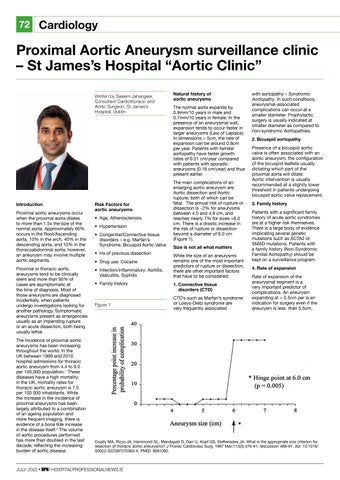72 Cardiology
Proximal Aortic Aneurysm surveillance clinic – St James’s Hospital “Aortic Clinic” Written by Saleem Jahangeer, Consultant Cardiothoracic and Aortic Surgeon, St James’s Hospital, Dublin
Introduction Proximal aortic aneurysms occur when the proximal aorta dilates to more than 1.5x the size of the normal aorta. Approximately 60% occurs in the Root/Ascending aorta, 10% in the arch, 40% in the descending aorta, and 10% in the thoracoabdominal aorta; however, an aneurysm may involve multiple aortic segments. Proximal or thoracic aortic aneurysms tend to be clinically silent and more than 95% of cases are asymptomatic at the time of diagnosis. Most of those aneurysms are diagnosed incidentally, when patients undergo investigations looking for another pathology. Symptomatic aneurysms present as emergencies usually as an impending rupture or an acute dissection, both being usually lethal. The incidence of proximal aortic aneurysms has been increasing throughout the world. In the UK between 1999 and 2010 hospital admissions for thoracic aortic aneurysm from 4.4 to 9.0 per 100,000 population.1 These diseases have a high mortality; in the UK, mortality rates for thoracic aortic aneurysm is 7.5 per 100 000 inhabitants. While the increase in the incidence of proximal aneurysms has been largely attributed to a combination of an ageing population and more frequent imaging, there is evidence of a bona fide increase in the disease itself.2 The volume of aortic procedures performed has more than doubled in the last decade, reflecting the increasing burden of aortic disease.
Risk Factors for aortic aneurysms • Age, Atherosclerosis • Hypertension • Congenital/Connective tissue disorders – e.g. Marfan’s Syndrome, Bicuspid Aortic Valve • Hx of previous dissection • Drug use: Cocaine • Infection/inflammatory: Aortitis, Vasculitis, Syphilis • Family history
Figure 1
Natural history of aortic aneurysms The normal aorta expands by 0.9mm/10 years in male and 0.7mm/10 years in female. In the presence of an aneurysmal wall, expansion tends to occur faster in larger aneurysms (Law of Laplace). In dimensions > 5cm, the rate of expansion can be around 0.8cm per year. Patients with familial aortopathy have faster growth rates of 0.21 cm/year compared with patients with sporadic aneurysms (0.16 cm/year) and thus present earlier. The main complications of an enlarging aortic aneurysm are: Aortic dissection and Aortic rupture, both of which can be fatal. The annual risk of rupture or dissection is ∼2% for aneurysms between 4.0 and 4.9 cm, and reaches nearly 7% for sizes >6.0 cm. There is a drastic increase in the risk of rupture or dissection beyond a diameter of 6.0 cm (Figure 1). Size is not all what matters While the size of an aneurysms remains one of the most important predictors of rupture or dissection, there are other important factors that have to be considered: 1. Connective tissue disorders (CTD) CTD’s such as Marfan’s syndrome or Loeys-Dietz syndrome are very frequently associated
with aortopathy – Syndromic Aortopathy. In such conditions, aneurysmal-associated complications can occur at a smaller diameter. Prophylactic surgery is usually indicated at smaller diameter as compared to non-syndromic Aortopathies. 2. Bicuspid aortopathy Presence of a bicuspid aortic valve is often associated with an aortic aneurysm; the configuration of the bicuspid leaflets usually dictating which part of the proximal aorta will dilate. Aortic intervention is usually recommended at a slightly lower threshold in patients undergoing bicuspid aortic valve replacement. 3. Family history Patients with a significant family history of acute aortic syndromes are at a higher risk themselves. There is a large body of evidence implicating several genetic mutations such as ACTA2 or SMAD mutations. Patients with a family history (Non-Syndromic Familial Aortopathy) should be kept on a surveillance program. 4. Rate of expansion Rate of expansion of the aneurysmal segment is a very important predictor of complications. An aneurysm expanding at > 0.5cm per is an indication for surgery even if the aneurysm is less than 5.5cm.
Coady MA, Rizzo JA, Hammond GL, Mandapati D, Darr U, Kopf GS, Elefteriades JA. What is the appropriate size criterion for resection of thoracic aortic aneurysms? J Thorac Cardiovasc Surg. 1997 Mar;113(3):476-91; discussion 489-91. doi: 10.1016/ S0022-5223(97)70360-X. PMID: 9081092.
JULY 2022 • HPN | HOSPITALPROFESSIONALNEWS.IE























